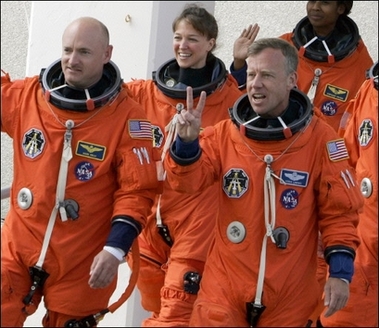Stormy weather prevented NASA from launching Discovery for the second day in
a row Sunday, extending a yearlong grounding of the space shuttle prompted by
persistent trouble with fuel-tank foam.

Space shuttle
Discovery commander Steve Lindsey (R) with fellow astronauts at the
Kennedy Space Center in Florida. Weather forced NASA to scrub the 01 July
launch, and may play a major role in the launch
later.[AFP] |
Launch officials said they would try again Tuesday, on the Fourth of July,
after giving the work force some rest and a chance to replenish the shuttle's
on-board fuel. The weather was expected to improve by Tuesday, although rain was
still in the forecast.
Launch director Mike Leinbach said it will be tight getting Discovery ready
for a Tuesday afternoon launch - only the second liftoff of a shuttle since the
2003 Columbia disaster and that any thunderstorms on Monday could put his team
behind.
He halted the countdown just an hour after the seven astronauts boarded the
fueled spaceship.
"Looking out the window it doesn't look good today," shuttle commander Steven
Lindsey radioed from the cockpit. He noted that July Fourth would be "a good day
to launch." It would be the first time NASA has ever launched a crew on the
holiday.
The afternoon sky was considerably darker than on Saturday and left NASA with
little choice but to call off the flight to the international space station.
Thunderstorms were moving in quickly from the west, and lightning was detected
within a few miles of the launch pad. The astronauts rode back to crew quarters
in the rain.
The back-to-back delays cost NASA an estimated $2 million in overtime pay and
fuel costs.
"After a year of preparation and after a very careful countdown, you don't
want to get into a rush and do something that is not smart from a weather
standpoint," said deputy shuttle program manager John Shannon, chairman of
NASA's mission management team. "Nobody is going to remember that we scrubbed a
day or two days a year from now. But if we go launch and get struck by lightning
or have some other problem, that will be very memorable."
Shannon said he told his team, "What a great gift NASA could give to the
nation to return the shuttle to operation on Independence Day."
"If the weather is good, that's exactly what we'll do," he said.
Among the invited guests who returned for the second launch attempt were
family members of the perished Columbia astronauts. Vice President Dick Cheney
was back in Washington after a brief visit to the space center Saturday.
Last month, NASA Administrator Michael Griffin approved launching the shuttle
despite the concerns of two top agency managers who wanted additional repairs to
the foam insulation on the external fuel tank. Columbia was brought down by a
chunk of flyaway foam, and a piece broke off Discovery's redesigned tank last
July, barely missing the shuttle.
"I've kind of steeped myself in this problem over the last month, and I am
quite confident that we've got a very good chance of flying and flying safely,"
Griffin said Sunday in an interview on CNN's "Late Edition with Wolf Blitzer."
Griffin has repeatedly pointed out that if Discovery were damaged during
launch, the astronauts always could take refuge on the space station until a
rescue vehicle is sent up.
Sen. Bill Nelson (news, bio, voting record), D-Fla., who flew on a space
shuttle in 1986 right before the Challenger disaster, defended Griffin's
decision on Sunday and said it was an acceptable risk.
NASA's top safety officer and chief engineer recommended at a flight
readiness review meeting two weeks ago that the shuttle remain grounded until
design changes are made to the foam that insulates 34 brackets on the fuel tank.
Without this foam, dangerous ice could form on the metal brackets once the tank
is filled with super-cold fuel.
As it is, more than 35 pounds of foam were removed elsewhere in what NASA
described as the biggest aerodynamic change ever made to the shuttle's launch
system. Shuttle managers said they wanted to fly with only one major change at a
time.
Once in orbit, Discovery's crew will test shuttle-inspection techniques,
deliver supplies to the space station and drop off German astronaut Thomas
Reiter for a six-month stay.
NASA hopes to add an extra day to Discovery's 12-day flight to test
spacewalking methods for repairing possible damage to the ship's thermal skin.
By replenishing the shuttle's on-board fuel now, the astronauts will have a
better chance of getting that additional day in orbit.